
HMCS Bonaventure was a Majestic-class aircraft carrier, the third and last aircraft carrier in service with Canada's armed forces. The aircraft carrier was initially ordered for construction by Britain's Royal Navy as HMS Powerful during the Second World War. Following the end of the war, construction on the ship was halted and it was not until 1952 that work began once again, this time to an altered design for the Royal Canadian Navy. The ship entered service in 1957 renamed Bonaventure and, until the vessel's decommissioning in 1970, was involved in major NATO fleet-at-sea patrols and naval exercises and participated in the Cuban Missile Crisis. During her career Bonaventure carried three hull identification numbers, RML 22, RRSM 22 and CVL 22. Following her decommissioning Bonaventure was sold for scrap and broken up in Taiwan.
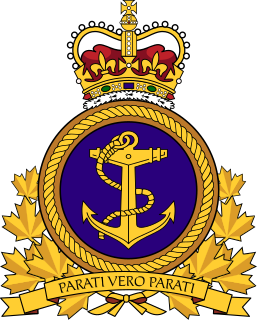
The Royal Canadian Navy is the naval force of Canada. The RCN is one of three environmental commands within the Canadian Armed Forces. As of 2021, the RCN operates 12 frigates, four attack submarines, 12 coastal defence vessels, eight patrol class training vessels, two offshore patrol vessels, and several auxiliary vessels. The RCN consists of 8,570 Regular Force and 4,111 Primary Reserve sailors, supported by 3,800 civilians. Vice-Admiral Craig Baines is the current commander of the Royal Canadian Navy and chief of the Naval Staff.
The history of the Royal Canadian Navy goes back to 1910, when the naval force was created as the Naval Service of Canada and renamed a year later by King George V. The Royal Canadian Navy (RCN) is one of the three environmental commands of the Canadian Forces. Over the course of its history, the RCN has played a role in the First World War, contributed significantly to the Battle of the Atlantic during the Second World War, and was a part of NATO's force buildup during the Cold War. In 1968, the RCN was amalgamated with the Canadian Army and the Royal Canadian Air Force to form what is today the unified Canadian Armed Forces. The naval force was known as Maritime Command until 2011, when the environmental command was renamed as the Royal Canadian Navy.
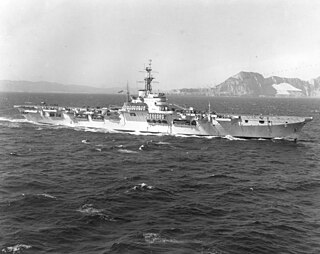
HMS Warrior was a Colossus-class light aircraft carrier which was ordered in 1942 by the British Royal Navy during World War II. Construction was finished in 1945 and upon completion, the aircraft carrier was loaned to the Royal Canadian Navy from 1946 to 1948 as HMCS Warrior. Warrior was returned to the Royal Navy in 1948 and entered service with the British. While in service with the Royal Navy, Warrior was modernised twice, including the installation of an angled flight deck in 1956. In 1948–1949, the ship was used in aircraft landing experiments and fitted with a rubber flight deck and in 1957, was used as the headquarters ship during nuclear testing at Christmas Island. In 1958, the vessel was sold to the Argentine Navy and entered Argentine service in 1959 as ARA Independencia. The aircraft carrier remained in service until 1970 when Independencia was placed in reserve. The following year, the ship was sold for scrap.
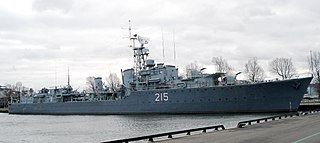
HMCS Haida is a Tribal-class destroyer that served in the Royal Canadian Navy (RCN) from 1943 to 1963, participating in World War II and the Korean War. She was named for the Haida people.

HMS Uganda was a Second World War-era Fiji-class light cruiser launched in 1941. She served in the Royal Navy during 1943 and 1944, including operations in the Mediterranean, and was transferred to the Royal Canadian Navy as HMCS Uganda in October 1944. She served in the Pacific theatre in 1945 and was put into reserve in 1947. When she was reactivated for the Korean War in 1952 she was renamed HMCS Quebec. She was decommissioned for the last time in 1956 and scrapped in Japan in 1961.

Royal Canadian Air Force Base Shearwater, commonly referred to as RCAF Shearwater, was a Canadian Forces base located 4.5 nautical miles east southeast of Shearwater, Nova Scotia, on the eastern shore of Halifax Harbour in the Halifax Regional Municipality. Following a base rationalization program in the mid-1990s, the Canadian Forces closed CFB Shearwater as a separate formation and realigned the property's various facilities into CFB Halifax. These include:

The Flower-class corvette was a British class of 294 corvettes used during World War II by the Allied navies particularly as anti-submarine convoy escorts in the Battle of the Atlantic. Royal Navy ships of this class were named after flowers.
Naval Air Station Halifax, also NAS Halifax, was a United States Navy Naval Air Station located in Eastern Passage, Nova Scotia, Canada.

HMCS Rimouski was a Royal Canadian Navy Flower-class corvette which took part in convoy escort duties during the Second World War. She fought primarily in the Battle of the Atlantic. She was named after Rimouski, Quebec.
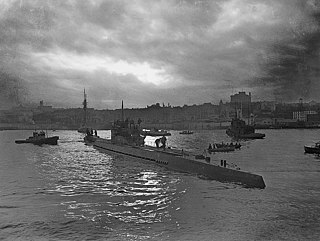
The Battle of the St. Lawrence involved marine and anti-submarine actions throughout the lower St. Lawrence River and the entire Gulf of Saint Lawrence, Strait of Belle Isle, Anticosti Island and Cabot Strait from May–October 1942, September 1943, and again in October–November 1944. During this time, German U-boats sank over 20 merchant ships and four Canadian warships. There were several near-shore actions involving the drop of German spies, or the attempted pickup of escaping prisoners of war. Despite the 23 ships lost, this battle marked a strategic victory for Canadian forces as ultimately they managed to disrupt U-boat activity, protect Canadian and Allied convoys, and intercept all attempted shore operations. This marked the first time that a foreign power had inflicted casualties in Canadian inland waters since the US incursions in the War of 1812.
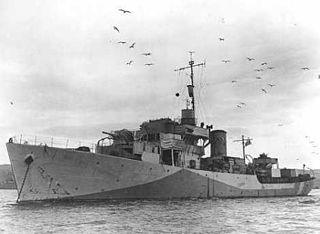
HMCS Long Branch was a modified Flower-class corvette that served in the Royal Canadian Navy during the Second World War. She was used primarily as a convoy escort in the Battle of the Atlantic. She was laid down as HMS Candytuft but was transferred to the RCN on 5 January 1944 before completion. She was named for Long Branch, Ontario, a village that was eventually amalgamated into Toronto, Ontario.

HMCS Regina was a Royal Canadian Navy revised Flower-class corvette which took part in convoy escort duties during the Second World War. She fought primarily in the Battle of the Atlantic. She was named for Regina, Saskatchewan.

HMCS New Glasgow was a River-class frigate that served in the Royal Canadian Navy during the Second World War and as a Prestonian-class frigate from 1955 to 1965. She was named for New Glasgow, Nova Scotia.

HMCS Halifax was a Royal Canadian Navy revised Flower-class corvette which took part in convoy escort duties during the Second World War. She served primarily in the Battle of the Atlantic. She was named for Halifax, Nova Scotia.

The convoy—a group of merchantmen or troopships traveling together with a naval escort—was revived during World War I (1914–18), after having been discarded at the start of the Age of Steam. Although convoys were used by the Royal Navy in 1914 to escort troopships from the Dominions, and in 1915 by both it and the French Navy to cover their own troop movements for overseas service, they were not systematically employed by any belligerent navy until 1916. The Royal Navy was the major user and developer of the modern convoy system, and regular transoceanic convoying began in June 1917. They made heavy use of aircraft for escorts, especially in coastal waters, an obvious departure from the convoy practices of the Age of Sail.

HMCS Algoma was a Flower-class corvette that served with the Royal Canadian Navy in the Second World War. Named for the Algoma District of Ontario, it served primarily in the Battle of the Atlantic. After the war it was sold to the Venezuelan Navy and renamed Constitución.

HMCS Lanark was a River-class frigate that served with the Royal Canadian Navy during the Second World War and again from 1956–1965 as a Prestonian-class frigate. She fought primarily in the Battle of the Atlantic as a convoy escort. She was named for Lanark, Ontario.

870 Naval Air Squadron, also known as VF-870, was a squadron of the Royal Canadian Navy (RCN). It was formed when 803 Naval Air Squadron of the Royal Navy was renumbered to 870 NAS on 1 May 1951. It operated throughout the 1950s and early 1960s before disbanding on 7 September 1962. It was the first RCN squadron to operate jet aircraft.
HMCS Vison was an armed yacht of the Royal Canadian Navy during World War II. The vessel was acquired in 1940 for use as a patrol boat and later, as a training ship. In 1946, following the end of the war, Vison was sold into private ownership. The vessel was constructed as Avalon in 1931 by Pusey & Jones of Wilmington, Delaware, United States on behalf of Ogden L. Mills, the Secretary of the United States Treasury. During its service during World War II, Vison participated in the Battle of the Atlantic and the Battle of the St. Lawrence escorting convoys and defending them against German U-boats.
















